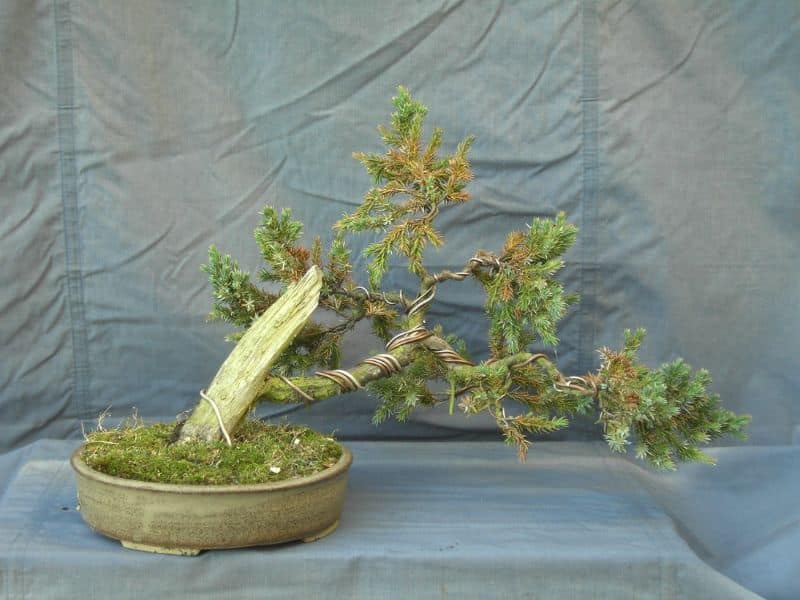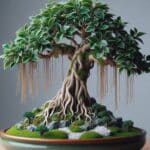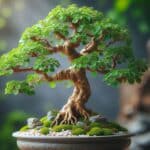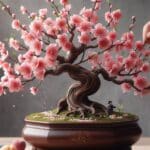Wiring is one of the many techniques used for shaping and cultivating bonsai trees. The method involves wrapping the tree trunk and branches in wires so these parts can be modified into a different shape or design.
Most tree species can be modified through wiring techniques, but some varieties, like palm trees, need to respond better to wiring.
Bonsai wiring can help you achieve a desirable bonsai shape, give your tree a more aged appearance, and make it look more appealing. This practice might seem complex, but it is much easier than you think.
In this guide, we will show you what wires to use and when to wire your tree and share some great wiring techniques that can help you enhance the structure of your tree.

When Should You Wire Bonsai Trees
Most bonsai tree species can be wired at any time of the year, but wiring is usually best in winter or before spring.
Deciduous trees will lose their leaves during the colder months, which makes it much easier to wrap delicate branches.
Even evergreen trees are easier to wire during winter since most of their new growth occurs during spring and summer. This new growth is tender and can easily snap off while wiring your tree.
Applying wire when the tree is still young and supple is also best. Once the trunk becomes woody, the wires might not be able to shape it anymore, and woody branches will be much more likely to snap off while you try to bend them.
What Wire To Use for Bonsai Tree Shaping
Before you wire your bonsai tree, invest in a wire cutter, pliers, and an appropriate wire type.
The wires will stay in place for many months, perhaps even years, and will be exposed to harsh elements like wind and rain. It is best to use a wire that is strong enough to shape the tree but also rust and corrosion-resistant.
Here is a quick look at some of the best wire types for bonsai wiring.

Aluminum Wire
Aluminum wire is naturally corrosion and rust-resistant but it is still soft and bendable. This type of wire is ideal for softer branches of broadleaf evergreen trees or deciduous trees because the softer wire reduces the risk of damage while wrapping the tree. This type of wire is also less likely to leave behind scarring when the tree grows.
Aluminum wire is usually applied at a 45 – 50 degree angle to bend or change the shape of thinner or softer branches.
Annealed Copper Wire
Copper wire is also rust and corrosion-resistant. This metal is harder and preferable for thicker or older branches. It is also a better material for wiring hardwood bonsai types like conifers and pines.
The stronger metal is more suited for bending and holding firm branches in place, and it is also preferable as a guy wire to bend trunks.
Copper wire is usually applied at a 60 – 65-degree angle to support the branch structure firmly.
Bonsai Wire Size
Bonsai wires can vary in thickness. They are usually available in sizes that range from 1 – 8mm thick. Most bonsai artists work with 1, 1.5, 2.5, and 4mm thick wiring.
The 4mm thick wire is suitable for the tree’s stems, while the thin wire is best used on thinner branches and twigs.
Raffia
To protect your tree from the impact that these wiring might cause while you are bending your tree, it is usually best to first soak the wires or branches of the tree in raffia.
Raffia is a type of palm fiber found at most gardening centers. This product creates a barrier between the wire and the tree and can protect your tree from scarring.
How to Wire a Bonsai Tree

Before you can start wiring the tree, prepare the tree a little bit for the process. Here is a quick look at the steps for preparing your tree for wiring.
- Bonsai wire in sizes 4mm, 2.5mm, and 1mm
- Raffia
- Bonsai wire cutter
- Bonsai shears or scissors
- A Bonsai pot
- An example of your desired shape
- Young tree with established roots
How to Prepare Bonsai Tree for Wiring
Before you can start wiring the tree, it is best to prepare the tree a little bit for the process. Here is a quick look at the steps for preparing your tree for wiring.
- Remove all the foliage from the top half inch of each branch so the wire can firmly grip onto the branch.
- Remove any crotch growth (small buds on the base of the branches) so these weak points won’t interfere with your wire’s grip.
- Prune away any opposing or unwanted branches.
- Ensure that the tree is healthy and hydrated before you get to work.
- It is best to water the tree properly before shaping and styling it.
Easy Steps to Wire Bonsai Trees
Once your tree is prepared, it will be time to start wiring your little tree. Here is a quick look at the steps for wiring a bonsai tree.
Anchor the Trunk
If you want to bend or modify the trunk of the tree, then you should anchor the base of the wire in the soil or pot. When wiring a bonsai tree, it is essential to always start from the thickest part of the tree. There are two different ways to anchor the wire to the base of your tree.
- The first method is practical if you are also repotting your bonsai tree. Before you add soil to the new pot, you can string the wire through the drainage holes on the base of the bonsai pot. This will allow you to securely “mount” the tree to the container. It is ideal for bigger trees that might be a little bit top-heavy.
- If your bonsai tree is already planted, then you can insert the wire flush deep into the soil until it feels stable and coil it upwards around the trunk.
Anchor the Branch Base
The first thing you should do is identify the branches that you would like to alter. Take some time to inspect your tree and narrow down all the branches that you want to modify.
Before you can start wiring the branches, you will need to anchor the wire to the branch. Start with the thickest part of the trunk and coil the wire twice around this thickened part to secure it firmly. Work your way up or outwards toward the thinner parts of the tree and keep wrapping the wire around the bonsai tree branches.
Double Wiring Bonsai Trees
Double wiring is a technique that is used to wire two branches simultaneously. With this method, you will be using a single but long wire. The wire should be folded in half before wrapping it around the branch.
The double wire will start at the base of the branch and work outwards. When the branches split, the wire will divert into single wiring and every single wire will be wrapped around each tree branch.
Single Wiring for Bonsai Branches
Single wiring is used when only one branch is wired. The wire is wrapped around the branch’s thick base and around the branch. Unlike double wiring, the wire won’t divert to another branch but will spool around that branch you want to modify.
Bending and Twisting Wired Branches
After wrapping the wire over the bonsai tree and all the branches you wish to modify, it is time to start bending the tree. To bend your branches, you can apply pressure to push them into the desired shape. The wries should keep these branches in place when you climb the tree.
It is best to bend and shape your tree slowly so you won’t accidentally snap any branches. It is much better to work slowly or to bend your tree in sections rather than risk snapping the branches. Many bonsai artists will re-wire their trees several times throughout the years until they achieve a desirable shape.
Once the wires have been bent, you should leave the tree alone. If you are constantly manipulating the branches, then you can cause damage to your tree.
Guy Wiring a Bonsai Tree
When the tree branches become hardened and too stiff to manipulate with double or single wiring, you can try guy wiring your tree.
Guy wire is a method bonsai artists use to manipulate and bend tree branches downwards. The wire is anchored to the branch, but instead of coiling it around the branch, it is anchored to another surface like the container, a surface root, or another strong branch.
1mm Thick wire is often used for guy wiring, but you should consider using plastic or protective padding so this thin wire won’t damage the tree.
To guy-wire the tree, you can start by wrapping the padding around the area you will be targeting. Next, hook a wire over this protective padding on the branch you want to pull down. You can now attach the guy wire to the bonsai pot, tree root, or some other type of anchor and attach it to the hook on your tree branch. Shorten the guy wire until the tree branch is in a suitable spot.
Once the guy wires have been positioned in place, you should leave them alone so the tree can stabilize and get used to its new shape.
Aftercare
Aftercare for wired branches or a wired bonsai tree is very important. If the wires are left on for too long, they can start cutting into the tree bark, which can cause a lot of damage to our tree. You should regularly inspect the branches and tree during its growing season and keep an eye out for bark damage.
If the wires start cutting into the bark, they should be removed.
To remove the wire, you should use a wire-cutting tool and, clip off the wire at each turn or circuit around the tree, and remove the cuttings.
Don’t attempt to unwind the wires so you can re-use them. If the wires are unwound, it will cause damage to the delicate growth.
How Long Do You Leave Bonsai Wiring On?

Bonsai wires are usually left in place for about 1 – 4 months but this can depend on the growth rate of the tree. On slow-growing trees, the wires can be left in place for up to a year. If you find the tree branches do not have the desired shape just yet then it is better to re-wire the tree rather than leave the wires in place for too long.
Final Thoughts
Wiring a bonsai tree is one of the best ways to train it into a more desired position or shape it into one of the popular styles. It can be a bit challenging to master this art form or get your branches properly trained, but learning to wire and structure a tree can be fun.
We hope this guide offered helpful guidance so you can adequately wire and structure your tree without causing damage. We are certain that, with some practice, you will soon become a skillful bonsai artist and that your trees will look quite impressive.







